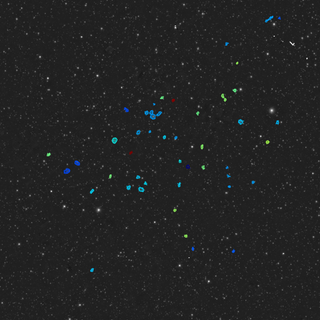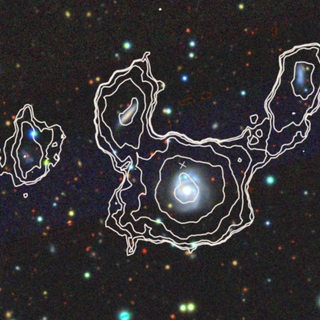Cosmic gold rush! Astronomers find 49 new galaxies in just 3 hours
"I did not expect to find almost 50 new galaxies in such a short time!"

Astronomers have been surprised by a "gold rush" of new galaxies, racking up 49 discoveries in just 3 hours.
The gas-rich galaxies were uncovered by a team using the MeerKAT radio telescope located in South Africa. They have been dubbed the "forty-niners," a callback to the nickname given to the thousands of gold miners who flocked to California during the state's Gold Rush, which peaked in 1849. The nickname is now carried by the San Francisco 49ers American football team.
The team of astronomers certainly wasn't playing around when it stumbled across the nearly 50 new galaxies. They were attempting to study star-forming gas in a single radio galaxy. Instead, they found 49 new galaxies in observations lasting about 180 minutes, thus demonstrating the power of MeerKat when it comes to revealing star-forming gas.
Related: Scientists find galaxy supercluster as massive as 26 quadrillion suns
Research leader Marcin Glowacki, from the Curtin University node of the International Centre for Radio Astronomy Research (ICRAR) in Western Australia, views the 49 new galaxies as "gold nuggets" for astronomers. Their discovery is arguably no less fortuitous than the discovery of the first gold chunks at Sutter's Mill in Coloma, California, which kick-started the California Gold Rush in 1848.
"I did not expect to find almost 50 new galaxies in such a short time," Glowacki said in a statement. "By implementing different techniques for finding galaxies, which are used for other MeerKAT surveys, we were able to detect all of these galaxies and reveal their gas content."

Many of the 49 newfound galaxies are located in close proximity to each other and form galaxy groups.
Get the Space.com Newsletter
Breaking space news, the latest updates on rocket launches, skywatching events and more!
Of these collections that come in an array of different shapes and sizes, three in particular have captured the imagination of Glowacki and colleagues. Of four galaxies seen in the same image, three are connected by the gas content that runs throughout them.

"These three are particularly interesting, as by studying the galaxies at other wavelengths of light, we discovered the central galaxy is forming many stars," Glowacki said. "It is likely stealing the gas from its companion galaxies to fuel its star formation, which may lead the other two to become inactive."
"We hope to continue our studies and share even more discoveries of new gas-rich galaxies with the wider community soon," said Glowacki.
Glowacki recently teamed up with ICRAR summer student Jasmine White, who also analyzed short observations made by MeerKAT to discover even more gas-rich galaxies.
"This discovery highlights the raw power of the MeerKAT telescope as an imaging instrument," research co-author and University of the Western Cape researcher Ed Elson said. "The methods we developed and implemented to study the forty-niners will be useful for MeerKAT large science surveys and smaller observing campaigns such as ours."
The team's research was published online Tuesday (March 26) in the Monthly Notices of the Royal Astronomical Society.
Join our Space Forums to keep talking space on the latest missions, night sky and more! And if you have a news tip, correction or comment, let us know at: community@space.com.

Robert Lea is a science journalist in the U.K. whose articles have been published in Physics World, New Scientist, Astronomy Magazine, All About Space, Newsweek and ZME Science. He also writes about science communication for Elsevier and the European Journal of Physics. Rob holds a bachelor of science degree in physics and astronomy from the U.K.’s Open University. Follow him on Twitter @sciencef1rst.
